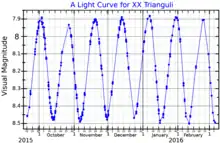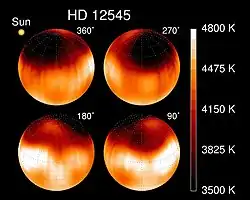| Observation data Epoch J2000.0 Equinox J2000.0 | |
|---|---|
| Constellation | Triangulum |
| Right ascension | 02h 03m 47.11380s[1] |
| Declination | +35° 35′ 28.6692″[1] |
| Apparent magnitude (V) | 8.1 – 8.7[2] |
| Characteristics | |
| Spectral type | K0 III[3] |
| U−B color index | +0.78[2] |
| Variable type | RS CVn[2] |
| Astrometry | |
| Radial velocity (Rv) | −26.35±0.18[4] km/s |
| Proper motion (μ) | RA: −53.222[1] mas/yr Dec.: −14.160[1] mas/yr |
| Parallax (π) | 5.0820 ± 0.0497 mas[1] |
| Distance | 642 ± 6 ly (197 ± 2 pc) |
| Orbit | |
| Period (P) | 23.96924 d[3] |
| Inclination (i) | 60±10[5]° |
| Details[5] | |
| Mass | 1.26±0.15 M☉ |
| Radius | 10.9±1.2 R☉ |
| Luminosity | 30+13 −8 L☉ |
| Surface gravity (log g) | 2.82±0.04 cgs |
| Temperature | 4,620±30 K |
| Metallicity [Fe/H] | −0.13±0.04 dex |
| Rotation | 24.3±0.02 days[2] |
| Rotational velocity (v sin i) | 19.9±0.7 km/s |
| Age | 7.7±3.1 Gyr |
| Other designations | |
| Database references | |
| SIMBAD | data |
XX Trianguli, abbreviated XX Tri, is a variable star in the northern constellation of Triangulum, about 1.5° to the WNW of Beta Trianguli along the constellation border with Andromeda.[7] It is classified as a RS Canum Venaticorum variable and ranges in brightness from magnitude 8.1 down to 8.7,[2] which is too faint to be visible to the naked eye. The system is located at a distance of approximately 642 light years from the Sun based on parallax,[1] but is drifting closer with a radial velocity of −26 km/s.[4]

This is a single-lined spectroscopic binary with an orbital period of 23.96924 days.[3] The visible component is an orange-hued K-type giant star with a stellar classification of K0 III,[3] indicating it has exhausted the supply of hydrogen at its core then cooled and expanded off the main sequence. It is around eight billion years old with 26% more mass than the Sun and has expanded to 11 times the Sun's radius. It is radiating roughly 30 times the luminosity of the Sun from its photosphere at an effective temperature of 4,620 K.[5]
The star is "covered with large high-latitude and even polar spots and with occasional small equatorial spots".[5] XX Tri is notable for having a huge starspot larger than the diameter of the Sun, discovered using Doppler imaging.[9] For its size, the star has a relatively rapid rotation rate of about 24 days. It has a weak, Sun-like differential rotation. The star appears to show a magnetic activity cycle of 26±6 years, although only a single cycle has been observed as of 2015.
References
- 1 2 3 4 5 6 Brown, A. G. A.; et al. (Gaia collaboration) (August 2018). "Gaia Data Release 2: Summary of the contents and survey properties". Astronomy & Astrophysics. 616. A1. arXiv:1804.09365. Bibcode:2018A&A...616A...1G. doi:10.1051/0004-6361/201833051. Gaia DR2 record for this source at VizieR.
- 1 2 3 4 5 K. G., Strassmeier; K., Olah (June 1992). "On the starspot temperature of HD 12545". Astronomy and Astrophysics. SAO/NASA Astrophysics Data System. 259 (2): 595–599. Bibcode:1992A&A...259..595S. ISSN 0004-6361.
- 1 2 3 4 Jetsu, L.; et al. (April 2017). "General Model for Light Curves of Chromospherically Active Binary Stars". The Astrophysical Journal. 838 (2): 20. arXiv:1612.02163. Bibcode:2017ApJ...838..122J. doi:10.3847/1538-4357/aa65cb. S2CID 119414915. 122.
- 1 2 Karataș, Yüksel; Bilir, Selçuk; Eker, Zeki; Demircan, Osman; Liebert, James; Hawley, Suzanne L.; Fraser, Oliver J.; Covey, Kevin R.; Lowrance, Patrick; Kirkpatrick, J. Davy; Burgasser, Adam J. (2004). "Kinematics of chromospherically active binaries and evidence of an orbital period decrease in binary evolution". Monthly Notices of the Royal Astronomical Society. 349 (3): 1069–1092. arXiv:astro-ph/0404219. Bibcode:2004MNRAS.349.1069K. doi:10.1111/j.1365-2966.2004.07588.x. S2CID 15290475.
- 1 2 3 4 Künstler, A.; et al. (June 2015). "Spot evolution on the red giant star XX Triangulum. A starspot-decay analysis based on time-series Doppler imaging". Astronomy & Astrophysics. 578: 25. arXiv:1504.02270. Bibcode:2015A&A...578A.101K. doi:10.1051/0004-6361/201525687. S2CID 119211401. A101.
- ↑ "XX Tri". SIMBAD. Centre de données astronomiques de Strasbourg. Retrieved 2020-12-12.
- ↑ Sinnott, Roger W.; Perryman, Michael A. C. (1997). Millennium Star Atlas. Vol. 1. Sky Publishing Corporation and the European Space Agency. p. 123. ISBN 0-933346-84-0.
- ↑ Strassmeier, K. G. (July 1999). "Doppler imaging of stellar surface structure. XI. The super starspots on the K0 giant HD 12545: larger than the entire Sun". Astronomy and Astrophysics. 347: 225–234. Bibcode:1999A&A...347..225S. Retrieved 18 April 2022.
- ↑ Nemiroff, R.; Bonnell, J., eds. (2 November 2003). "A Giant Starspot on HD 12545". Astronomy Picture of the Day. NASA.
